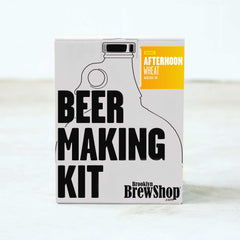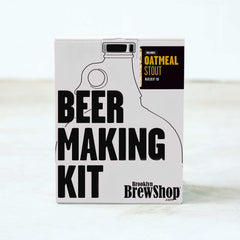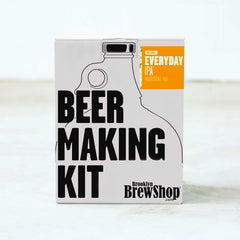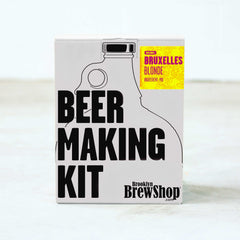Recipe:
Spent Grain Macarons
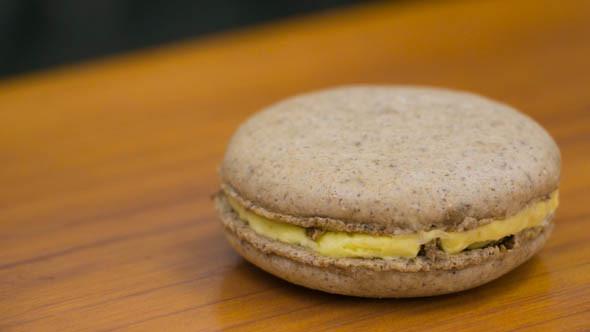
Oh yes, we went there -- while experimenting with our baked goods, and our Spent Grain Flour, we accomplished the biggest baking feat of all: the macaron. Because while such a delicate little pastry may be comprised of just a few ingredients, the recipe is a challenge -- less experienced bakers beware. Ours is a twist on a recipe for classic macarons by Thomas Keller.
A macaron, when done right, will delight your tastebuds. When made with spent grain flour, the nuttiness of the spent grain balances out the rich buttercream filling. The final result? A creamy, delectable pastry that is well worth the time and effort.
The key to perfecting the macaron? Precise measurements. That's why we included weight measurements as well as volume measurements; we've found that using tablespoons and teaspoons ensures about a 75 percent success rate for macarons. On the other hand, using a scale to measure out ingredients in grams resulted in a 100 percent success rate. If at all possible, use a metric scale to measure out ingredients for successful macarons.
WHAT YOU NEED (FOR THE COOKIES)
- 1 3/4 cups + 2 1/2 tablespoons (212g) Spent Grain Flour, sifted
- 1 3/4 cups + 1 tablespoon + 2 teaspoons (212 grams) powdered sugar
- Approximately 3 large egg whites (1/4 cup + 1 1/2 tablespoons, or 82 grams)
- Approximately 3 large egg whites (1/4 cup + 2 tablespoons, or 90 grams)
- 1 vanilla bean
- 1 cup + 3 tablespoons (or 236 grams) granulated sugar
- 2/3 cup (or 58 grams) water)
WHAT YOU NEED (FOR THE FILLING)
- 2 sticks (230 grams) unsalted butter at room temperature and cut into small cubes
- 3 tablespoons + 1/2 teaspoon (or 38 grams) granulated sugar
- 3 tablespoons + 1/2 teaspoon (or 38 grams) granulated sugar
- 2 1/2 egg yolks (1/4 cup + 1/2 teaspoons, or 63 grams)
- 1/4 cup + 2 1/4 teaspoons (or 75 grams) whole milk
- 1/2 vanilla bean
WHAT YOU DO (FOR THE COOKIES)
- Preheat oven to 400 degrees Fahrenheit.
- Sift the Spent Grain Flour and powdered sugar in a bowl and mix together to combine.
- Make a well in the center of the mixture and add 3 egg whites (or 82 grams) to the well and mix until combined. This will take some time, but the ingredients will eventually come together into a wet dirt-like consistency
- Place the sugar and water in a saucepan and heat over medium-high heat until it reaches a temperature of 212 degrees Fahrenheit (keep heat on after this temperature).
- Place remaining 3 egg whites (90 grams) in the bowl of a stand mixture with a whisk attachment and add a pinch of sugar. Whip on medium until the egg whites form soft peaks. Drop speed to lowest setting to keep them moving.
- Continue cooking sugar and water mixture until the syrup reaches a temperature of 248 degrees Fahrenheit. Take off of heat. Turn mixture up to medium-low and slowly drizzle syrup down the side of the bowl with the mixture running.
- Turn mixture up to medium speed and whip the meringue for 5 minutes, or until fluffy and glossy. The mixture should have cooled in this time; if not, continue to whip until room temperature.
- Scrape the seeds from the vanilla bean and add to the meringue.
- Take 1/3 of the meringue and mix into the spent grain mixture. Mix until well combined.
- Take another 1/3 of the meringue and gradually fold it into the spent grain mixture, being sure not to deflate the meringue.
- Fold in the final 1/3 of the meringue until just combined. Transfer mixture to a piping bag fitting or cut to ½ inch tip.
- Line two sheet pans with parchment paper and pipe meringue into 2-inch circles, leaving at least one inch between them. Tap the bottom of the sheet pan to release and trapped air bubbles
- Add one sheet pan to the oven and reduce the temperature to 325 degrees Fahrenheit and bake for 10-12 minutes until the tops are shiny and crispy.
- Remove sheet pan and set aside to cool.
- Reheat oven to 400 degrees Fahrenheit. Once heated add second pan to the oven and again, drop temperature to 325 degrees Fahrenheit. Bake for 10 to 12 minutes and remove from the oven to let cool.
- While cookies are cooling, make filling
WHAT TO DO (FOR THE VANILLA BUTTERCREAM FILLING)
- In a small bowl, whisk together the egg yolks and 3 tablespoons plus 1/2 teaspoon of granulated sugar.
- Add milk and remaining sugar to a small saucepan and bring to just below a simmer.
- While constantly whisking, slowly add hot milk mixture to egg yolk mixture.
- Place egg yolk and milk mixture back into the saucepan and bring to a gentle simmer while whisking constantly. Once mixture comes to a simmer, continue to cook and stir for 1 minute, or until mixture thickens (be careful not to let the eggs curdle).
- Strain mixture into the bowl of your mixer fitted with the whisk attachment. Mix on medium for at least 8 minutes, or until the mixture if cooled completely
- Continue mixing and slowly add the butter a few cubes at a time. Make sure the previous addition has been completely worked into the mixture before adding more butter.
- The buttercream should be able to hold its shape and not be loose at all. If it is too runny, place in the fridge for an hour or so and then beat again in the mixture for a minute to fluff it up. Transfer to a piping bag fitted with a tip or cut to 3/8 inches
WHAT TO DO (TO COMPLETE THE COOKIES)
- Turn half of the cookies with the bottom (flat side) facing up.
- Starting in the center, slowly pipe approximately 1 tablespoon of buttercream in a spiral pattern going outwards, but not quite reaching the each of each cookie.
- Gently press the second half of the cookies with the bottom (flat side) facing down onto the cookies with the buttercream piped on them.
- Enjoy fresh, or wrap in plastic wrap and freeze for up to 2 weeks for later enjoyment. Defrost in the fridge for at least 4 hours before enjoying.
Shop Beer Making Kits
We make all-grain beer brewing kits that make it easy to make beer at home. Whether it's your first batch or your hundredth.

